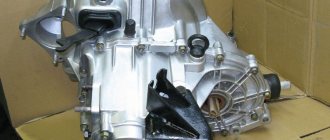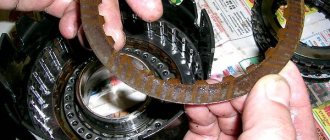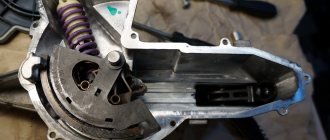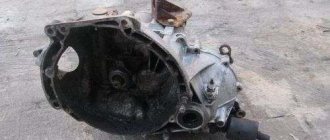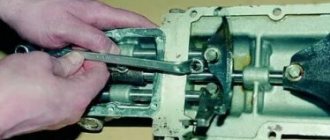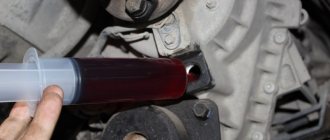Gearbox VAZ 2107: what is it
What is a gearbox in a car design? The abbreviation “KPP” stands for “gearbox”. This is the name of the unit, which is designed to change the frequency of torque.
The purpose of the gearbox is to perform the function of converting the amount of torque that comes from the engine and transferring this energy to the transmission. This is the only way to change speeds in increasing increments.
The gearbox on the VAZ 2107 appeared in 1982 along with a new model in the AvtoVAZ line - the “seven”. Structurally and practically, this gearbox is still considered the most advanced unit among classic manual gearboxes.
For the first time, five-speed gearboxes began to be installed on the VAZ 2107
Gearbox device
The VAZ 2107 is equipped with a five-speed gearbox, that is, changes in the torque frequency are possible in five positions. At the same time, five gears allow you to drive forward at different speeds, and the sixth is considered reverse and is activated at the moment when the driver needs to reverse.
The shift pattern for these gears is no different from the classic four-speed one that was installed on earlier VAZ models. The driver just needs to depress the clutch pedal and move the gearshift lever to the desired position.
The external design of the box does not allow us to understand the internal design of the elements
It should be noted that, structurally, the box on the “seven” is a rather complex device, so the diagnosis and repair of this device is usually trusted only to professionals. However, the “seven” gearbox adopted the main parameters from the “five” one, since AvtoVAZ designers took the VAZ 2105 as the basis for the new gearbox.
Table: gear ratio ratios for VAZ 2105 and VAZ 2107
| Model | VAZ 2105 | VAZ 2107 |
| Main couple | 4.3 | 4.1 / 3.9 |
| 1st gear | 3.667 | 3.667 |
| 2nd | 2.100 | 2.100 |
| 3rd | 1.361 | 1.361 |
| 4th | 1.000 | 1.000 |
| 5th | 0.801 | 0.820 |
| Rear | 3.530 | 3.530 |
Speaking about the general design of the gearbox on the VAZ 2107, it should be borne in mind that externally it has the shape of a closed housing. In this case, only three of its sides are completely closed (special durable covers are used for this), and the fourth side of the box “grows” into the gear shift knob. All lids fit tightly to the box, their joints are sealed.
The checkpoint consists of up to 40 elements
The main elements of gear shifting are “hidden” in the gearbox housing:
- input shaft (four drive gears and synchronizers are installed on it);
- secondary shaft (ten gears are mounted on its surface at once);
- intermediate shaft.
Let's consider each element separately in order to understand at least the general principle of the design and operation of the gearbox.
Primary shaft
Just by the name you can understand that the input shaft is the fundamental element of the box. Structurally, the shaft is one piece with four gears and rotates together with them on a bearing. The rotating bearing itself is fixed in the lower part of the box and is sealed with an oil seal to ensure reliable connection.
All gears located on the shaft have different dimensions for ease of connection
Secondary shaft
We can say that the secondary shaft is, as it were, a logical continuation of the primary housing in space. It contains gears for 1st, 2nd and 3rd gears (that is, all odd numbers). All ten gears on this shaft have different dimensions, and therefore ensure the conversion of torque.
The secondary shaft, like the primary shaft, rotates on bearings.
The secondary shaft can be called the main element of the gearbox due to the increased loads that fall on its gears
Intermediate shaft
The main task of this element is to serve as a kind of “layer” between the primary and secondary shafts. It also has gears that are integral with the shaft, through which torque is transmitted from one shaft to another.
The main task of this element is to interface the work of the primary and secondary shafts
Set of forks
Ease of gear shifting while driving is provided by a set of forks. They are driven by the shift lever. The forks press on one or another gear of a certain shaft, causing the mechanism to work.
The fork is used to change the gears of the car.
Gearbox oil for VAZ 2101
The oil in the “penny” gearbox, like in any other vehicle unit, needs to be replaced periodically. But before you perform this procedure, you need to know when and how to replace it and what lubricant to use.
What kind of oil to pour into the box of a VAZ 2101
Today there is a wide selection of transmission oils for cars. The difference between them lies in the additives used, or, more precisely, in their classes. There are the following classes of markings: from GL 1 to GL 5. For the VAZ 2101 gearbox, the best option is considered to be GL 5 class oil with a viscosity grade of 85W90 or 80W90. This lubricant is intended for hypoid gears and provides good lubrication of rubbing elements even under high loads. In addition, GL 5 oil can be used not only for the gearbox, but also for the rear axle. Of the manufacturers, preference should be given to those who are suitable in terms of price.
The VAZ 2101 gearbox must be filled with GL5 class gear oil with a viscosity of 85W90 or 80W90
Checking the oil level
For the gearbox to function properly, the oil level in the crankcase must always be optimal. It needs to be checked periodically. If the grease level in the box is normal, it should be level with the bottom edge of the filling hole. The oil volume in the VAZ 2101 gearbox crankcase is 1.35 liters.
How often to change the oil in a VAZ 2101 gearbox
Although transmission oil is rarely changed, you still need to know when this procedure is necessary. As a rule, on a “classic” it is done every 40–60 thousand km. mileage or 3 years from the date of filling.
How to drain the oil
To drain the oil from a VAZ 2101 gearbox, you will need a hex wrench and a container of suitable volume, for example, a cut-off plastic bottle. Using a hexagon, unscrew the drain plug, which is located in the lower cover of the crankcase, and drain the oil.
To drain the oil from a VAZ 2101 gearbox, unscrew the drain plug in the bottom cover of the box using a hexagon.
The drain plug is wiped clean of dirt and screwed back into place.
In addition, you need to pay attention to the drained oil and, if there is metal dust in it, you will need to repair the box as soon as possible
How to fill oil
To fill the gearbox with lubricant, you need to unscrew the filler plug with a 17mm wrench and clean it of dirt. The oil is poured in the required volume using a special syringe. Many people do not measure the required volume of lubricant, but simply fill it in until it begins to flow back out. After filling, immediately screw the plug into place. Instead of a syringe, you can use homemade devices if you have the desire and time to make them.
Oil is poured into the gearbox using a special syringe through the oil filler hole.Intermediate shaft
Designed to transmit a certain amount of torque from primary to secondary. Rotates on bearings 2, 22 and 19. The gears are integral with the shaft. In the same block, gears of the fifth speed 18 and rear 20 are installed. The latter is installed on a separate shaft 21, connected to the secondary one on splines.
To fill the VAZ 2107 gearbox with oil, there is a special hole 11 on the left side of the housing, which is closed with a plug. The bottom of the case is closed with a steel lid, which is secured with ten nuts. All connections between the lids and the box body are sealed with special gaskets that prevent oil leakage. The bearings of the primary, secondary and intermediate shafts are sealed with seals that prevent oil from leaking out of the transmission pan.
The filling volume of oil for the VAZ 2107 gearbox is approximately 1.6 liters. Some car enthusiasts prefer to fill oil through the top, at the place where the handle is inserted into the gearbox. This method is much simpler than the standard one, since the handle is located in the interior and access to it is not difficult, which cannot be said about the filler hole.
Gear shifting is controlled by a set of forks that are driven by a handle. The structure and main details of the gear shift mechanism are clearly illustrated by the following diagram.
Here numbers 1, 2 and 16 indicate the gear shift forks: third and fourth, first and second, rear and fifth, respectively. Numbers 5, 7 and 9 indicate the rods of the corresponding forks, which are driven by handle 8, located in the interior of the VAZ 2107 car.
The operating diagram of the switching mechanism is as follows: when handle 8 changes its position, its hinge engages with a recess on one of the rods, the other end of which is rigidly coupled to the fork with a bolt 3. The fork, in turn, fits into a groove on the corresponding front gear (16 , 23, 24, 25) or intermediate (20) reverse. Thus, handle 8 ensures the movement of the fork and a certain gear of the secondary shaft is engaged with the corresponding intermediate gear. In this case, the torque transmission chain is closed, the secondary shaft begins to rotate at a speed corresponding to the gear ratio of the gears currently engaged. When the reverse gear is engaged, unlike the others, the handle is “recessed” down when moving.
As you can see, the design of the VAZ 2107 gearbox is quite complex, so it is not recommended to repair it without having the appropriate skills. It is better to entrust this matter to specialists.
The VAZ 2107 is equipped with two types of gearboxes, one of which is four-speed and the other five-speed. Sooner or later, these devices begin to malfunction, as a result of which it becomes almost impossible to drive a car. In this material, we will find out what the repair of both types of gearboxes on a VAZ 2107 is, what are the differences between these two mechanisms, and when repair work is required.
The hum of the input shaft of the VAZ 2107
- To the beginning of the forum
- Forum Rules
- Old design
- FAQ
- Search
- Users
The first gear makes a lot of noise, it feels like you are driving a huge bus (it somehow makes noise and even, in my opinion, vibrates), the rest are not very loud, just a little, but the third and fifth are louder than 2 and 4.
Gears shift easily and do not fall out.
Question: 1. Is the problem serious? 2. Is it possible to drive with it if you don’t pay attention to the noise? 3. If urgent repairs are needed, can they add up to the cost of a new gearbox?
No, you don’t have to, you just throw it over and everything is ok. If I were you, I would leave the 5th mortar. Take a look yourself.
I don’t know about you, but with us it costs RUB 4,500 to rebuild a box, without spare parts. If you change something, you can purchase “raw spare parts”. So you can go through this box every day. I was going through my box with a friend. Everything was great. Now in the spring we will have to open it up again and change the second gear synchro, it turned out to be bad.
Actually the problem is the same: noise in the gearbox. Symptoms: when you stand still, you can clearly hear a noise in the cabin, you press the clutch and the noise disappears. The box heats up, the tunnel above the box is noticeably warm. Oil is ok. I understand that repairs are required, I am going to do it myself. Please provide an approximate list of parts that need to be changed. Because if something happens, it’s a long way to run to the store, but you want to do it quickly.
Problems with reverse gear on automatic transmission
In practice, gearbox malfunctions associated with engaging reverse gear occur on both manual and automatic transmissions. "Automatic machines" have different designs. Robotic boxes are similar in design to “mechanics”. But the automatic transmission has its own list of breakdowns when it works hard or the reverse gear has disappeared.
- The fluid level is below normal, or it is contaminated and has lost its working qualities. The automatic transmission device is sensitive to the quality of the lubricant and its level. Therefore, it is better to start finding out the cause by checking the transmission fluid. An excessive oil level also contributes to improper operation of the unit. The service life of the fluid is limited to a mileage of 60 thousand km, but sometimes it is necessary to change it more often, as the lubricant becomes cloudy and contaminated.
- Wear of friction discs. The correct operation of reverse gear, as well as the “D” (drive) mode, depends on this. Worn clutches may prevent 3rd, 4th and reverse gears from engaging. In this case, eliminating the breakdown consists only of replacing the clutches.
- The splines on the drive drum are cut off. The car can move forward, but it will be impossible to go backward.
- Worn friction brake band. There is no reverse movement, but forward movement works.
- The brake band piston cuffs are torn or worn. This will only be noticeable when you engage reverse.
- Control solenoids or hydraulic units are jammed.
Sometimes the lack of communication between the torque converter and the oil pump gear also affects the reverse operation.
The process of dismantling and disassembling the transmission
Disassembly and reassembly of the gearbox if any malfunction is detected should be performed in the following sequence:
- de-energize the system by removing the negative contact from the battery;
- dismantle the radio panel;
- slightly move the locking sleeve down and remove it from the rod cavity;
- with a sharp movement we pull the rod out of the gear shift lever;
- remove the upper and lower bushings from the lever;
- dismantle the gearbox cover, which is fixed with four screws;
- remove the cover that protects the handbrake from dirt, and then unscrew all the fasteners located on the floor of the car;
- dismantle the hoses through which warm air is supplied to the air filter;
- move the starter forward a little, then unscrew the gearbox housing plug and drain the transmission oil;
- dismantle the muffler and disconnect the universal joint, the reverse switch and the speedometer cable, which connects the part to the gearbox;
- disassemble the clutch housing cover and the cardan drive;
- disconnect the last fastenings of the gearbox, move it back a little and remove it out.
Rules for disassembling and assembling the gearbox
If the user has never encountered the repair of such a complex unit, the procedure should be carefully prepared.
- Disassembly of the mechanism is carried out only after it has been completely cleaned of dirt.
- All the tools required for disassembly are pre-prepared - keys, squeezes, pliers, lock ring pullers. It is also advisable to have a separate container for storing small bolts, nuts, and washers.
- It is necessary to dismantle the mechanism parts by first treating the bolts with an anti-boiling agent.
- When disassembling, the units are folded in the dismantling sequence.
- Human memory is extremely unreliable - a photograph of a disassembled mechanism before its reassembly is the best reminder.
- All gaskets without exception must be replaced. Recycling of seals is strictly prohibited.
- No one has canceled the abundance of the cleaner. When washing the structure, you should not skimp on the cleaning material; the better you wash it, the more fun it will be.
- Assembly of the unit is carried out exclusively in the reverse order.
- If after installation there are excess parts left (which is not uncommon), the entire gearbox is completely rebuilt.
It is also necessary to maintain maximum cleanliness during work. Dust, metal shavings, or foreign objects can cause serious damage to the gears.
Elimination of breakdowns in mechanisms
Based on the results of diagnosing the gearbox of a VAZ 2107 car, a decision is made to carry out routine repairs or replace the unit. Performing an operation to restore the functionality of the box is quite a costly operation, both in terms of time and finances. To identify the cause, it will be necessary to dismantle the mechanism, disassemble it and defect the parts. Performing this type of work requires experience and professionalism.
The answer to the question why the five-speed gearbox on a VAZ 2107 is constantly noisy will allow you to fix the breakdown at minimal cost. You should not immediately agree to replace the mechanism until all repair options have been exhausted. The gearbox has a significant service life and, with timely maintenance and repairs, can be used for almost the entire service life of the vehicle.
Source
Replacing oil seals
Structurally, the oil seal is a sealing device that closes the passage to oil. When a part wears out, the housing stops holding liquid and an oil leak occurs.
To dismantle the part, you will need to perform a certain sequence of actions.
Input shaft oil seal
The procedure is performed like this:
- completely disassemble the gearbox to open access to the oil seal;
- pry off the seal ring with an awl;
- remove the oil seal itself from the shaft;
- Installation of the new part is carried out in the reverse order.
Secondary shaft oil seal
Disassembling the secondary shaft oil seal is more difficult.
- Remove the centering device from the shaft flange.
- Use a special puller to pull the flange off the secondary shaft along with the washer;
- Use a screwdriver to pry the oil seal out of its socket.
- Carefully install the new seal.
How to eliminate noise in the mechanics of Lada Granta
Before starting treatment for the Grants checkpoint and eliminating the howling, it is necessary to identify the cause of the problem. If rattling appears after running in a new car with a VAZ-2181 manual transmission, think about soundproofing the interior. In other cases, the problem requires repair.
Diagnostics
Without removing the unit, you can determine the malfunction of the mechanical transmission by sound:
- a squeak is heard when shifting into gear 1-3 - check the bearings;
- The transmission howls in 5th gear - check the oil volume;
- hum in any gear, including neutral - wear of the bearings (release or input shaft) is possible.
Diagnostics of the Lada Granta gearbox
A slight metallic rattle and crunch may appear after the box is repaired, which indicates a low qualification of the assembler.
Sometimes it is difficult to determine by ear what exactly is making the unpleasant noise. It's not just the box that can howl. If a strange cracking sound appears when you depress the clutch pedal and the gears are not engaged accurately, with a crunch, the problem may be with the release bearing. Other causes of noise are wear of the synchronizer elements, blocking rings, and an increase in the gap between the blocking ring and the gear. If possible, contact a car service center for diagnostics.
It is more difficult to detect the source of howling in a machine gun or robot "Grant". Partial or complete disassembly of the box will be required. The on-board computer (multitronics) may display the error “Gearbox faulty” (if it is missing, look at the dashboard and the icon in the form of a gear with an exclamation mark). Sometimes the message is not true and disappears after removing the battery terminal and discharging the capacitors. If rebooting the system does not help, you will have to call a tow truck and take the Grant to a service center.
Troubleshooting
There are several ways to get rid of box noise. The choice of method depends on the cause of the howling:
- Vibrations occur between the clutch cable and fork. A new rubber gasket can reduce vibration vibrations. Cut a washer from a soft material, remove the clutch cable from the fork and glue a new gasket in place of the factory one.
- Rebuilding the transfer case and replacing failed bearings will help eliminate the howling of the gearbox on the Grant that occurs during acceleration.
- A slipping clutch is corrected by tightening the clutch pedal. If eliminating the weakening does not help, you will have to buy a repair kit consisting of a pressure and driven disk and a clutch release bearing. Prolonged repairs may lead to the need to completely replace the clutch.
- If the grinding noise appears after repair, the treatment for the howling of the Grants gearbox is to have the gearbox overhauled at a trusted auto repair shop.
Troubleshooting
If the unpleasant noises of the VAZ-2181 gearbox do not disappear (as they are caused by an unsuccessful design), you can improve the sound insulation of the cabin.
Some drivers solve the problem of humming by adding special additives to the oil. According to the manufacturers of the compounds, the substances are capable of restoring worn-out gearbox elements. Such promises are a marketing ploy. The metal is not able to recover under the influence of foreign inclusions.
Additives can reduce grinding and humming and delay repair time for minor damage, but you will still have to sort out the box. In case of severe levels of wear, adding a special fluid to the oil does not eliminate the noise of the box. The use of compounds that are not suitable for the type of gearbox installed on the Grant can damage the transmission.
Replacing bearings
Most often, problems with the gearbox begin with the bearings breaking. Therefore, the bulk of all breakdowns lead to the driver needing to disassemble the gearbox and change the bearings.
Main shaft bearing
To change the input shaft bearing, you need to have the same tools as when disassembling the gearbox. The work is not difficult, but it can take a lot of time (depending on the physical fitness of the performer and his skill).
The operating procedure is as follows:
Clamp the input shaft with a vice
It is better to line the jaws of the vice with a soft cloth so that they do not deform the surface of the shaft. Use a puller to clamp the bearing and begin to slowly pull it off the shaft. Periodically you need to tap the bearing with a hammer and rotate the shaft between hits, otherwise misalignment may occur in the rollers and it will be very difficult to remove the bearing. Gradual knocking out will cause the bearing to jump off the shaft. Press a new bearing onto the shaft using the same method. It is important to only hit the inner ring of the bearing with a hammer and do so carefully. The job may take up to 30 minutes.
The job may take up to 30 minutes
Video: replacement instructions
Secondary shaft bearing
Replacing the secondary shaft bearing is carried out according to the same principle as the primary one. The only difference is that different types of bearings are used for different shafts.
Each type is strictly regulated for gearbox mechanisms
The hum of the input shaft of the VAZ 2107
Unread message by VladiZlav » Tue Nov 04, 2008 19:46:47
Unread message by DonPedro » Tue Nov 04, 2008 20:19:52
Unread message Wolf » Wed Nov 05, 2008 19:04:42
Unread message by VladiZlav » Wed Nov 05, 2008 19:13:50
Unread message Wolf » Thu Nov 06, 2008 20:01:16
Unread message Vladimir S » Thu Nov 06, 2008 20:48:30
Unread message by VladiZlav » Thu Nov 06, 2008 21:18:35
Unread message Vladimir S » Fri Nov 07, 2008 10:38:14
Unread message by VladiZlav » Fri Nov 07, 2008 11:53:41
Unread message Vladimir S » Fri Nov 07, 2008 20:10:31
I’ll pump it soon and tell you, but now I’ve been climbing and adding oil to the gearbox, about 300 grams have been added
Added after 2 hours 8 minutes 45 seconds:
You start to grab it almost at the policeman, I also noticed that the rear one engages normally after any other, and if I immediately engage the rear one, then with a bang (
Unread message NikVE » Sat Nov 08, 2008 9:19:44 AM
Unread message by VladiZlav » Sat Nov 08, 2008 18:38:28
Unread message Vladimir S » Sun Nov 09, 2008 17:09:05
Unread message Wolf » Mon Nov 10, 2008 19:09:35
wrote: Wolf wrote: so what should I do? Should I change the input shaft and the bearings on it?
When you assembled the box, did you try the input shaft play? By the way, fill all bearings with grease, especially release grease, it is generally sold dry (it sucks to fill it, but it’s necessary!)
there are 2 nuts, large and small, the large one is the adjusting nut, the small one is the lock nut. release the locknut and unscrew the adjuster towards the trunk, then you will have enough in the middle or at the end of the pedal stroke. if you unscrew (or screw) towards the engine, it will grab right to the floor. In any case, you must have 3-5mm of free movement of the presser foot, otherwise the release will move. I have about 2-3cm from the floor. The trouble is that if the gap is completely removed, the gears will engage better, but the clutch will soon come in.
Added after 19 hours 34 minutes 26 seconds:
In general, they changed the input shaft - the hum disappeared. things like that, I didn’t even think of blaming him
Source
What is the gearbox ratio?
Gearbox ratios are quotients of the number of driven teeth divided by the number of drive gear teeth. Also, gears with high gear ratios are called “short”, and low gears are called “long”.
The physical meaning is as follows: since the engine (crankshaft and input shaft) always has the highest rotation speed,
and the rotational speed of the cardan is always lower (that’s why the gearbox is called a gearbox - a reduction gearbox), with the exception of 5th gear, where the gear ratio is less than 1, then the gear ratio is the number of revolutions of the driveshaft per one revolution of the crankshaft.
There is a general rule: the larger it is, the shorter the time it will take when pressing the gas pedal to gain the maximum number of revolutions. Accordingly, the transmission will be more powerful, the car will “jump” forward, but at the same time the driver must be prepared for a quick shift. And, as soon as the car has accelerated significantly, you need to prepare to switch. Therefore, a drop in speed is typical at high speeds.
In order to improve the dynamics of the car during acceleration, you can, of course, tune the carburetor. But if you decide to do something real, you need to change the main gear ratio, the main gearbox pair.
In a gearbox there is such a thing as a row - a set of shafts and gears.
A little history:
- Initially, the VAZ was equipped with a four-speed gearbox 2101;
- then, in 1976, the “Nivov” gearbox, or 2121, appeared. It was distinguished by a higher range, where the gear ratio was low (after all, an SUV)! In addition, it was equipped with “sixes” with a volume of 1.6 liters;
- a year before the Olympics - 80, checkpoint 2105 appeared;
- Currently, only 2107, 21074 and in some places you can find 2106 are on sale. All other boxes are discontinued;
- Gearbox 2107 exists for a five-speed gearbox, it is called 21074, the difference is that there is a place for mounting the reverse gear unit and fifth gear;
In order not to bore the reader, we present these gear ratios in the table for the 2101 gearbox, the ancestor of the gearboxes (in fact, of course, a Fiat design) and the VAZ 2107.
| VAZ 2101 | VAZ 2107 | |
| 1 | 17 | 18 |
| 2 | 29 | 28 |
| 3 | 15 | 14 |
| 4 | 33 | 33 |
| 5 | 3.753 | 3.667 |
| 6 | 20 | 20 |
| 7 | 27 | 27 |
| 8 | 2.303 | 2.1 |
| 9 | 24 | 24 |
| 10 | 21 | 21 |
| 11 | 1.493 | 1.361 |
| 12 | 1 | 1 |
| 13 | — | 38 |
| 14 | — | 20 |
| 15 | — | 0.819 |
- – number of teeth on the input shaft (main pair);
- – number of teeth on the intermediate shaft (main pair);
- – intermediate shaft 1;
- – secondary shaft 1;
- – gear ratio of 1st gear;
- — intermediate shaft 2;
- — secondary shaft 2;
- — gear ratio 2nd gear;
- — intermediate shaft 3;
- — secondary shaft 3;
- — gear ratio 3rd gear;
- — gear ratio 4th gear;
- — intermediate shaft 5;
- — secondary shaft 5;
- – gear ratio 5th gear. VAZ 2107 does not.
Even with a superficial analysis, these gear ratios say the following:
- all gear ratios of the VAZ 2107 are slightly lower than those of the VAZ 2101, this makes the box “softer”;
- in 4th gear we have 1, which means that the driveshaft and crankshaft are connected directly;
- There is a 5th gear, which causes the wheels to rotate faster than the input shaft, since the ratio is less than one.
What exactly is making noise and why?
Let's try to understand this issue. The main causes of noise coming from the gearbox are:
- improper operation of the gearbox, in particular the use of counterfeit transmission fluid purchased on the black market and operation of a vehicle with a non-working clutch;
- poor quality of gearbox components;
- maximum service life of manual transmission;
- unskilled technical work on diagnostics and repair of gearboxes.
New manual gearbox from VAZ 2109
In addition, the main malfunctions that may result in noise in the gearbox are:
- sudden difficulty switching on speed: in order to engage one or another gear, the driver will sometimes need to move the gearbox lever several times to the neutral position with the clutch depressed;
- The box automatically switches off the car’s gear while driving;
- Transmission fluid may leak from the gearbox.
It should also be noted that the VAZ 2109 gearbox can make noise in various conditions: at neutral speed, while shifting gears, or simply while driving at a certain speed. And each of these noises can indicate a different malfunction of the box.
In addition, during diagnostics, one must not forget that only one external sign may indicate several malfunctions in the gearbox. Therefore, it is virtually impossible to visually (i.e., by the type of hum) calculate which component of the box has failed. The damage can only be determined by removing and disassembling the box.
It is also necessary to add that repairing a transmission and eliminating defects requires a lot of knowledge, so it is better not to do this at home. The gearbox is an important unit in the structure of any vehicle, so it is better to entrust its repair and diagnostics to a qualified specialist.
Tuned VAZ 2109
Often the hum of the unit manifests itself:
- when you press the clutch;
- when turning on the third and fourth speeds;
- at neutral speed;
- when driving a car at high speeds.
Most domestic VAZ 2109 car owners face such problems. But if when you press the clutch, extraneous sounds disappear, then this may indicate several breakdowns. In particular, the fifth speed or reverse gear may fail. In addition, the input shaft bearing or release bearing may be faulty.
As practice shows, in the case of bearings the problem is not critical. If noise appeared in your car and then disappeared after several hundred or thousand kilometers, then most likely the remaining bearings were simply ground up by the unit system.
If your VAZ 2109 starts making noise, this does not mean that the bearings or reverse gear have failed. These problems are the most common, but only high-quality diagnostics can specifically determine what has gone wrong.
REPAIR
The VAZ 2107 has a 5-speed gearbox, which, despite the comparative simplicity of its design, can become unusable for reasons classic for manual transmissions:
- wear and tear due to natural reasons: high mileage, irregular operation and depletion of the service life of components, weather conditions not meeting the desired ones, and as a result - a decrease in service life, etc.;
- non-compliance of the working fluid with standards suitable for normal operation of the transmission;
- non-original spare parts included in the box;
- damage to the gearbox housing due to mechanical impact;
When it comes to the gearbox, even if it is a Zhiguli, the best option would be to entrust diagnostics and maintenance to specialists at a service station. Fortunately, repairing it will not cost too much, except in rare cases that require a complete replacement of the entire mechanism, when it would be more advisable to purchase the same new car.
The gearbox howls on a VAZ 2107: causes and solutions
The transmission of the “Seven” is exceptionally reliable and unpretentious during operation.
Natural wear of parts of units can cause the appearance of extraneous sounds during operation; the gearbox howls, usually due to an increase in gaps in the interfaces between parts. Diagnosing the cause of a breakdown of a complex mechanism is quite difficult; this requires knowledge about the device and the principle of its operation. The VAZ 2107 is equipped with a five-speed manual gearbox, which consists of the following parts:
The occurrence of a malfunction is mainly due to wear of parts, while the box makes different noise depending on the nature of the breakdown.
Box faults
The design of the “Seven” gearbox is designed for many years of service. Usually the driver carries out the first and even the second major overhaul of the engine, and only after that does the need to repair the gearbox arise.
In addition, the “seven” itself has acquired a reputation as a “workhorse” throughout its long history. The machine really serves faithfully for many years, but this does not mean that each of its mechanisms will not wear out over time.
If we talk about malfunctions of the VAZ 2107 gearbox, then most often drivers complain about three defects: the inability to engage the desired gear while driving, the gear being knocked out and a strong crunch in the box.
The transmission does not start
It is very difficult to drive a vehicle if the driver cannot change gear. On the one hand, the shift lever moves to the desired position, but, on the other hand, switching as such does not occur. Or the lever cannot be set at all to the desired speed switching position.
In any case, the problem lies precisely in the box:
- Some of the moving (hinge) elements of the shafts are very worn out - it is recommended to carry out a major overhaul of the gearbox;
- wear of the blocking rings on the synchronizer - replace the rings with new ones;
- the synchronizer spring is stretched or broken - replace the spring;
- severe wear of the gear splines - only complete replacement of the gear will help.
Knocks out gear when driving
Another common problem with the gearbox is the transmission slipping out of gear immediately after turning it on. The lever simply throws back, and the engine begins to experience overloads, since at high speeds it does not receive the required distribution number.
The malfunction may be associated with different elements of the box:
- jamming of the hinge on the gear shift lever - it is necessary to remove the lever skirt, clean all connections and lubricate them;
- breakage of the lever - it is impractical to carry out repairs; it is easier to immediately replace the lever with a new one;
- the clutch does not work correctly - in this case, the entire blame cannot be placed on the box; it is quite possible that after adjusting the main elements of the clutch, the gear will not be knocked out;
- The forks in the box are bent - it is recommended to replace the entire set of forks.
Crunching and grinding in the box while driving
The driver may not experience problems with shifting gears, but while driving, hear a loud knocking, crunching and grinding sound in the gearbox cavity:
- the bearings on the shafts are broken - replacement is recommended;
- The gear splines are badly worn - the entire gear needs to be replaced;
- minimum oil level in the cavity of the box - you need to add lubricant and make sure that there is no leak;
- malfunction of the shafts (they began to move along another axis) - replacement of bearings on both shafts.
Replacing and adjusting the gearbox driveshaft
So, if only reverse does not work, and all other modes do not fail, then you will need to replace the universal joint and adjust it. To do this, prepare a new spare part, a gear selector shaft seal, a set of keys, a hammer and several screwdrivers of different sizes.
Carry out the work according to the instructions:
Place the machine on an overpass or over a pit. Find the gearbox from below and loosen the clamp bolts on its drive rod. Remove the actuator completely from the stem. Using a screwdriver, pull the boot towards the unit. Often the boot is completely damaged during this step, in which case it can be removed and then a new one installed
Unscrew the fixing screw on the universal joint. Carefully tap the driveshaft off the assist shaft with a hammer. Remove the boot if you haven't damaged it previously
Install a new oil seal on the speed shaft. Install a new boot, place the cardan on the shaft so that the position of the fixing screw coincides with the recess on the shaft. Tighten the retaining screw and place the rod on the rod, but do not tighten the clamp. To make the adjustment, ask an assistant to move the gearshift lever to the neutral position and a short distance to the right. He should hold it in this position while you tighten the clamp.
https://www.youtube.com/watch?v=sAUaUF67F0o
If the reason for the failure of the reverse gear was hidden in the cardan of the carriage, then you will no longer have problems after this repair.
Gearbox device
In general, the concept of “remaking” the box is not entirely correct, since the design of the VAZ-2105 gearbox with 4 speeds was practically no different from the same gearbox 2101. The 2105 gearbox has a three-shaft layout, with constant gear meshing and manual control. Externally, the Kopeika and Pyaterki checkpoints can be distinguished almost only by the markings on the body of the box.
The VAZ-2105 gearbox diagram with 4 stages is presented below, and structurally it does not differ from modifications 2101 and 2106:
| 1 | Bottom cover; | 40 | Needle bearing of the front end of the secondary shaft; |
| 2 | Filler and inspection plug; | 41 | Synchronizer spring thrust washer; |
| 3 | Intermediate shaft second gear gear; | 42 | Fourth gear synchronizer ring gear; |
| 4 | Intermediate shaft third gear gear; | 43 | Sliding clutch for synchronizer of third and fourth gears; |
| 5 | Intermediate shaft; | 44 | Third and fourth gear synchronizer sliding clutch hub; |
| 6 | Front intermediate shaft bearing; | 45 | Synchronizer retaining ring; |
| 7 | Clamp washer bolt; | 46 | Synchronizer locking ring; |
| 8 | Intermediate shaft front bearing clamp washer; | 47 | Synchronizer spring; |
| 9 | Intermediate shaft constant mesh gear; | 48 | Third gear synchronizer gear and ring gear; |
| 10 | Constant mesh gear of the input shaft; | 49 | Second gear synchronizer gear and ring gear; |
| 11 | Spring washer; | 50 | Secondary shaft; |
| 12 | Retaining ring; | 51 | First gear synchronizer gear and ring gear; |
| 13 | Rear input shaft bearing; | 52 | First gear gear bushing; |
| 14 | Input shaft oil seal; | 53 | Secondary shaft intermediate bearing; |
| 15 | Transmission front cover; | 54 | Intermediate bearing lock plate; |
| 16 | Bearing mounting ring; | 55 | Secondary shaft reverse gear; |
| 17 | Clutch housing; | 56 | Elastic cushion for gear shift lever damper; |
| 18 | Gearbox input shaft; | 57 | Damper rubber bushing; |
| 19 | Reversing light switch; | 58 | Damper spacer; |
| 20 | Intermediate shaft reverse gear; | 59 | Damper locking sleeve; |
| 21 | Reverse intermediate gear; | 60 | Inner gear shift lever cover; |
| 22 | Reverse fork; | 61 | Secondary shaft rear bearing oil seal; |
| 23 | Gear shift lever release spring; | 62 | Flange of the elastic coupling of the propeller shaft; |
| 24 | Tension spring bolt; | 63 | Screw; |
| 25 | Gear shift lever guide cup; | 64 | Centering ring seal; |
| 26 | Ball joint of the lever; | 65 | Centering ring retaining ring; |
| 27 | Spherical washer; | 66 | Centering ring; |
| 28 | Spring; | 67 | Rear secondary shaft bearing; |
| 29 | Gear shift lever; | 68 | Drain plug; |
| 30 | First and second gear shift fork; | 69 | Mud deflector; |
| 31 | Third and fourth gear shift fork; | 70 | Speedometer drive gear; |
| 32 | Fork rod for first and second gears; | 71 | Speedometer drive; |
| 33 | 3rd and 4th gear fork rod; | 72 | Rear gearbox cover; |
| 34 | Locking blocks; | 73 | Reverse idler gear axis; |
| 35 | Reverse fork rod; | 74 | Rear intermediate shaft bearing; |
| 36 | Rod lock ball; | 75 | Intermediate shaft first gear; |
| 37 | Retainer spring; | 76 | Gearbox housing; |
| 38 | Retainer cover; | 77 | Sliding clutch for synchronizer of first and second gears. |
| 39 | Breather; |
Since the box from the VAZ-2105 is structurally similar to the 2101, the kinematic diagram of the gearbox is the same. But the gear ratios are different; on 2105 gearboxes they are:
- 1st – 3.67;
- 2nd – 2.10;
- 3rd – 1.36;
- 4th – 1.00;
- Rear – 3.53;
As for the differences in the design between gearboxes 2105 and 2101, they mainly come down to different numbers of teeth on different gears. So, on the intermediate shaft of the gearbox, a 1st speed gear with 14 teeth is used (15 for 2101), and their inclination angle is greater. The constant mesh gear of this shaft has 28 teeth (29 for 2101). The input shaft uses an 18-tooth gear (19 for 2101). Because of these features, the shafts with gear blocks of these two gearboxes are not interchangeable if you try to install them separately. But in the case of a complex replacement - the input shaft along with the intermediate shaft and all gear blocks, then installation is quite possible. As for the secondary shaft, modification 2105 differs from shaft 2101 in the first gear gear (its teeth have a different angle, although their number is the same, and its diameter is also slightly larger).
VAZ 2107 box repair
Before starting work, you should thoroughly clean the outer surface of the gearbox and wash it with kerosene.
Important: before repairing the VAZ 2107 gearbox, it is necessary to drain the transmission oil from it. It's easier to do this before removing it from the car.
Further actions are performed in the following sequence:
- Remove the clutch fork from the gearbox.
- Remove the rubber coupling flange from the gearbox output shaft.
- Unscrew and remove the cross member securing the gearbox.
- Remove the speedometer drive.
- Remove the reverse lamp switch.
- Remove the cuff from the ball joint of the gearshift lever.
- Unscrew the nuts securing the gearshift lever housing cover to the rear wall of the crankcase.
- Remove the housing and gasket from the studs.
- Unscrew the nuts securing the gas exhaust pipe.
- Remove the mounting bracket and remove the mounting bolt.
- Unscrew the 5 nuts of the gearbox rear cover with a 13mm wrench.
- Unscrew the 10 nuts of the bottom cover with a 10mm wrench.
- Remove the cover along with the gasket.
- Unscrew another rear cover nut.
- Press in the 1st and 2nd gear rods using a screwdriver.
- Tapping the rear cover, remove it from the gearbox along with the gasket.
- Remove the plug for the reverse gear and 5th gear block (repairing the 5th gear of a VAZ 2107 often involves replacing worn gears or bearings).
- Remove 5th gear and reverse gear.
- Place the rear cover on wooden blocks and press out the 5th gear block bearing.
- Remove the sealing gasket.
- Press the oil seal out of the front gearbox cover and remove it with pliers (if it needs to be replaced).
- Remove the spring ring from the gearbox shaft.
- Unscrew the bolt securing the front bearing and remove it along with the washers.
- Unscrew the gear bolt
- Move the 5th gear fork and remove the gear block.
- Clamp the gear block in a vice.
- Remove the secondary shaft washer.
- Unscrew the cover bolts and remove the cover together with the gasket.
Important: repairing a VAZ 2107 gearbox involves mandatory replacement of all gaskets with new ones. Therefore, before work you should stock up on a set of gaskets.
- Remove the springs and fixing rods from the crankcase holes.
- Remove the retaining balls using a rubber bulb (by creating low pressure in it).
- Remove the 5th gear and synchronizer from the output shaft.
- Remove the ring.
- Remove the 5th gear clutch by sliding the shift fork.
- Remove the reverse idler gear from the axle.
- Remove the reverse and 5th gear shift rod, shift fork and rod bushing.
- Unscrew the bolt securing the rod.
- Pull out the locking pin.
- Release the locking ring associated with 5th gear.
- Remove the hub, spring washer, gear and reverse bearing from the shaft.
- Remove the front intermediate shaft bearing.
- remove the intermediate shaft.
- Remove the rear bearing ring part.
- Unscrew the bolt securing the 3-4 gear fork to the rod.
- Remove the 3-4 gear rod and fork.
- Pull out the locking pin.
- Unscrew the fastenings of the 1-2 gear fork.
- Remove the rod and fork of 1-2 gears.
- Unscrew the screws securing the secondary shaft bearing plate using an impact screwdriver.
- Pull the bearing out of the crankcase.
- Remove the input shaft.
- Remove the roller bearing from the shaft.
- Pry off the retaining ring of the secondary shaft intermediate bearing and remove the bearing.
- Remove the secondary shaft.
- Unscrew the nut and remove the reverse axle.
- Remove the 3-4 gear synchronizer and the hub shaft spring washer from the shaft.
- Remove the stabilizer clutch hub and 3rd gear.
- Press the secondary shaft out of the gear.
- Remove the shaft gear bushing and remove the gear and 1st gear synchronizer.
- Remove the 1st-2nd gear clutch hub and the synchronizer clutch.
- Remove the 2nd gear and bearing race.
- Remove the Belleville washer.
- Press the secondary shaft out of the bearing race.
- Pull out the retaining ring and 4th gear spring.
- Continue repairing the VAZ 2107 gearbox (5 mortar), disassembling other gears.
- Replace all worn parts with new ones.
- Reassemble the gearbox by performing the steps in reverse order.
A short summary
General structure of manual gearboxes on VAZ
The device of a 5-speed manual transmission Lada Priora, Kalina. General diagram of the gearbox.
New cable transmissions installed on car models with 16-valve engines have become much quieter even when braking the engine. They have reinforced synchronizers (which, however, cannot be called problem-free). They are capable, according to the passport data, of withstanding a torque of 160 Nm. In practice, they work properly even under much higher loads when the car engine is boosted.
You should not think that we are deliberately praising VAZ manual gearboxes; we only noted their well-deserved positive qualities. But, of course, they encounter problems during operation. Let us note the most common malfunctions, their causes and solutions.
Table of the most common malfunctions of VAZ manual gearboxes, as well as their elimination and repair
The most successful manual transmission on Ladas is considered to be the one installed on the Lada Vesta
A new level in the design of VAZ manual gearboxes for front-wheel drive cars has become the VAZ 21807 gearbox, this is a five-speed manual transmission installed on the Lada Vesta. It is considered one of the most successful manual transmissions, as it is reinforced and capable of holding high torque. Problems such as gearbox noise, rapid wear of bearings and gears, oil leaks from seals are not typical for this box, but knocking at idle sometimes occurs, although not on all copies, which is an amazing phenomenon.
It should also be noted that the VAZ 21809 manual transmission is installed on the Lada X-ray. It is as durable as the VAZ 21807, but in the operational practice of owners, oil seal leaks and difficulty in engaging reverse gear are often encountered.
Lada X-ray with manual transmission, which is also quite successful
Gear shift diagram for a 4-speed manual transmission used on VAZ 2101, 2102, 2103, 2104, 2105, 2106, 2107, Niva 2121
Small Summary
So, what can we ultimately say about manual transmissions on VAZs and Ladas? Probably the fact that they started out in the 70s with phenomenally high quality, then the 5-speed manual transmissions suffered a little in quality, which, of course, slightly upset the owners. But it’s also impossible not to note how VAZ figured out (well, almost figured out) many of the problems of its manual transmissions. Just look at the box of the Lada Vesta and its Sport version, with a boosted 140 horsepower engine, how wonderfully the box works with a torque of as much as 180 Nm!
All VAZ boxes are incredibly repairable; they can be restored from any condition, and this can be done for relatively little money. Another big question is the quality of spare parts for gearboxes on our market. Now we are talking not only about cheap analogues, but, unfortunately, also about factory spare parts.
Thank you for your attention to this article, we tried to collect a lot of useful information about the operation and repair of VAZ manual transmissions, problems and ways to solve them, as well as other information about VAZ gearboxes. We hope you found it interesting and found something useful and necessary for yourself! Source
Source
The main reasons for unit failure
The crankcase of the transmission mechanism of the VAZ 2107 car contains a special oil of the TAD-17 brand, which lubricates the parts and reduces friction. Noise that appears during operation may indicate a drop in the level of technical fluid or a decrease in its anti-friction properties. If the transmission hums in all driving modes and at idle, check the oil level.
To answer the question why the gearbox makes strange sounds, it is necessary to carry out a simple diagnostic procedure:
The observations obtained as a result of such a test need to be analyzed.
